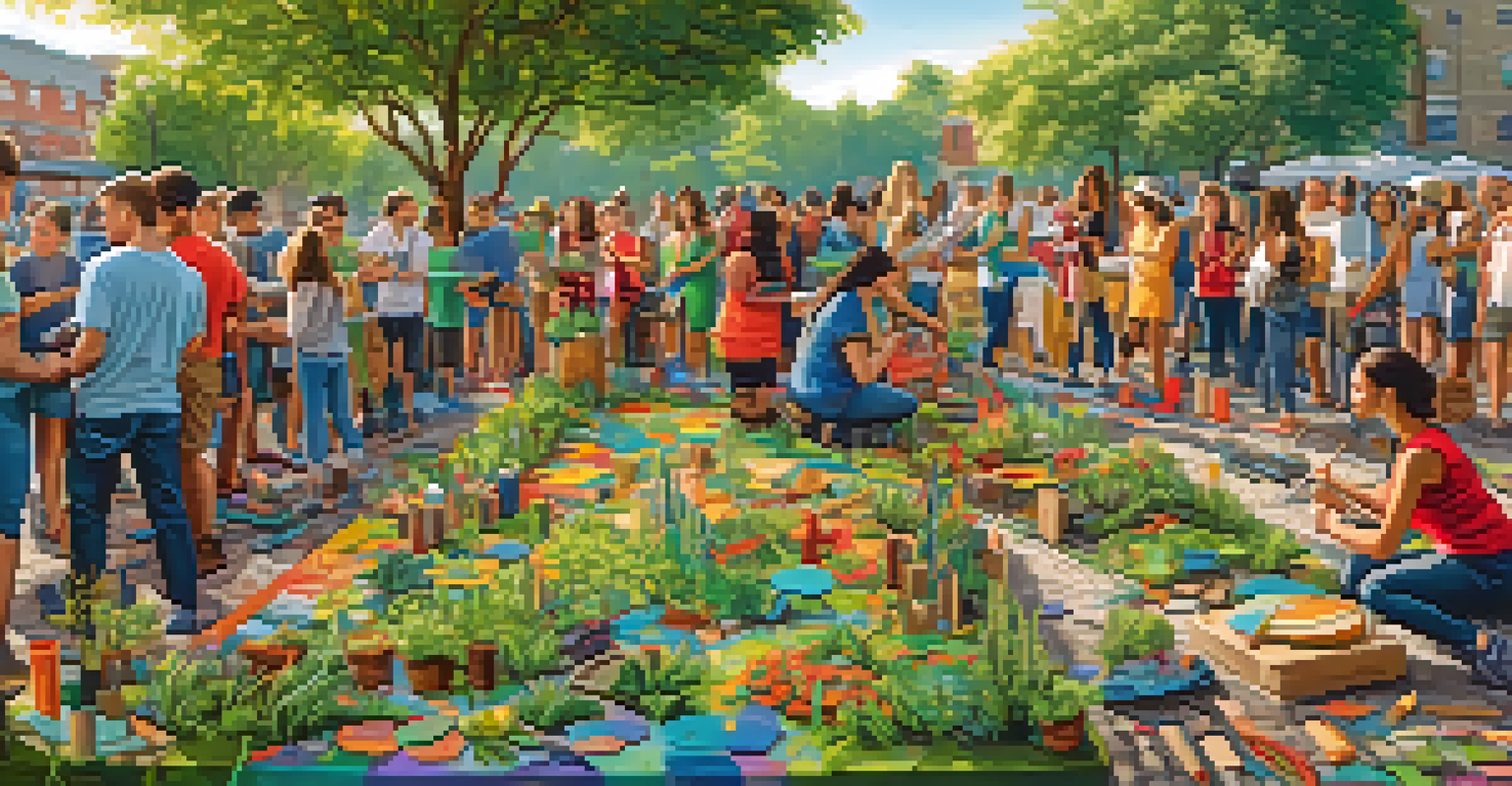The Influence of Minimalism on Eco-Art and Land Art

Defining Minimalism: A Foundation for Eco-Art
Minimalism is an art movement that emphasizes simplicity, focusing on the essence of a subject by stripping away excess. In the context of eco-art, this approach resonates deeply, as it encourages artists to reflect on nature's beauty without unnecessary embellishments. By distilling their work to its core elements, artists can better communicate their environmental messages, making the artwork more impactful and thought-provoking.
The greatest artist is the one who knows how to use the least.
This stripped-down aesthetic aligns perfectly with the principles of eco-art, which seeks to raise awareness about ecological issues. For instance, an installation using only natural materials can highlight the importance of sustainability without overwhelming the viewer with complex designs. Thus, minimalism serves as a powerful tool in eco-art, fostering a clearer dialogue between the artwork and its audience.
Moreover, minimalism's focus on simplicity encourages viewers to engage more deeply with the materials and processes involved in eco-art. By eliminating distractions, audiences can contemplate the relationship between art, nature, and their own environmental responsibilities. As a result, minimalism not only enriches the artistic expression but also enhances the educational aspect of eco-art.
The Intersection of Minimalism and Land Art
Land art, often created in outdoor settings, shares many philosophical underpinnings with minimalism, particularly in its focus on the landscape. Artists like Robert Smithson and Andy Goldsworthy have utilized minimalistic forms to create significant artworks that blend seamlessly with their surroundings. By using natural materials and simple shapes, these artists invite viewers to reconsider their relationship with the environment, emphasizing the beauty inherent in simplicity.

For instance, Goldsworthy's ephemeral works, which often dissolve back into nature, highlight the transient beauty of the landscape while embracing minimalism. Such pieces challenge the conventional understanding of art as a permanent object, pushing the boundaries of how we define artistic value. This interplay between land art and minimalism ultimately leads to a deeper appreciation for the earth, encouraging viewers to reflect on their own impact on the environment.
Minimalism Enhances Eco-Art Impact
By focusing on simplicity, minimalism allows eco-artists to communicate urgent environmental messages more effectively.
In this context, minimalism not only enhances the aesthetic appeal of land art but also reinforces its environmental message. The simplicity of form allows the natural landscape to shine, making the artwork a part of the ecosystem rather than an imposition upon it. This synergy between minimalism and land art serves as a reminder of our responsibility to preserve the beauty of our planet.
Eco-Art: A Response to Environmental Challenges
As environmental issues become increasingly pressing, eco-art emerges as a vital response, often influenced by minimalist ideals. Artists who adopt this approach use their work to comment on climate change, pollution, and habitat destruction, aiming to inspire action and awareness. The minimalist aesthetic allows for a direct and poignant expression of these themes, often evoking a visceral reaction from the audience.
Simplicity is the ultimate sophistication.
The use of minimal materials in eco-art not only signifies a commitment to sustainability but also encourages viewers to reconsider their consumption habits. For example, an artwork made from recycled materials can starkly contrast with consumerist culture, prompting reflection on waste and resourcefulness. By embodying these values in their art, eco-artists contribute to a broader conversation about environmental stewardship.
Moreover, eco-art often fosters community engagement, inviting local populations to participate in the creation process. This collaborative aspect not only amplifies the message but also empowers individuals to take ownership of their surroundings. In this way, minimalism becomes a catalyst for meaningful dialogue and action within communities facing environmental challenges.
Nature as a Canvas: The Role of Environment in Art
The natural world serves as both inspiration and medium for many eco-artists, making it an integral part of their creative process. By adopting minimalistic approaches, artists can effectively highlight the intrinsic beauty of nature without overshadowing it with excessive detail. This practice invites viewers to engage with the landscape itself, fostering a deeper appreciation for the environment.
Artists often work directly in natural settings, using materials found on-site to create their pieces. This not only establishes a strong connection between the artwork and its surroundings but also emphasizes the importance of preserving these landscapes. When art is created with minimal intervention, it encourages a sense of harmony between human creativity and the natural world.
Community Engagement Through Art
Minimalist eco-art projects invite community collaboration, fostering a shared sense of purpose and environmental activism.
Through this relationship with nature, artists can communicate powerful messages about environmental conservation and sustainability. By showcasing the fragility of ecosystems through their minimalistic works, they provoke critical conversations about humanity's role in protecting the planet. Thus, nature becomes a vital partner in the artistic process, shaping both the message and the medium.
The Impact of Digital Minimalism on Eco-Art
In a world increasingly dominated by digital technology, digital minimalism presents a unique intersection with eco-art. This approach advocates for simplicity in digital spaces, focusing on essential content while minimizing distractions. Eco-artists can leverage this philosophy to create virtual experiences that highlight environmental issues without overwhelming viewers with information.
For example, a digital installation featuring minimalist visuals can effectively communicate complex ecological themes while maintaining viewer engagement. This balance between simplicity and depth allows eco-artists to reach broader audiences through online platforms, making their messages more accessible. Additionally, digital minimalism encourages artists to think critically about their own environmental impact in the creation and distribution of their work.
Furthermore, the integration of technology into eco-art practices can lead to innovative solutions for environmental challenges. By using digital tools to visualize data about climate change or biodiversity loss, artists can create compelling narratives that resonate with audiences. In this way, digital minimalism not only enhances the impact of eco-art but also fosters a more sustainable approach to sharing artistic expressions.
Community Engagement: Minimalism as a Tool for Action
Minimalism in eco-art often fosters community engagement, inviting individuals to participate in the artistic process. By simplifying the art-making experience, artists can encourage collaboration and dialogue among participants, leading to a shared sense of purpose. This communal approach helps bridge the gap between art and activism, inspiring collective action toward environmental issues.
For instance, community-driven eco-art projects may involve local residents in creating installations that reflect their shared concerns about the environment. This not only strengthens community bonds but also empowers individuals to take ownership of their surroundings. The minimalist approach, with its focus on essential elements, allows participants to engage with the project's message without feeling overwhelmed.
Future of Eco-Art Embraces Technology
The evolution of eco-art will likely integrate minimalism with new technologies to create impactful narratives about sustainability.
Moreover, these collaborative efforts can raise awareness about local environmental challenges, creating a platform for discussion and advocacy. By working together to create art, communities can spark conversations about sustainability and inspire others to take action. In this way, minimalism serves as a powerful catalyst for change, uniting individuals toward a common goal of environmental stewardship.
Future Directions: Evolving Minimalism in Eco-Art
As the world continues to grapple with environmental crises, the influence of minimalism on eco-art is likely to evolve. Artists are increasingly exploring innovative ways to communicate urgent ecological messages while maintaining simplicity. This evolution may involve blending traditional minimalistic techniques with new technologies, offering fresh perspectives on sustainability and environmental awareness.
For example, artists could experiment with augmented reality to create immersive experiences that invite viewers to engage with environmental issues. By incorporating minimalist design principles, these installations could distill complex themes into digestible, impactful narratives. This fusion of technology and minimalism can help capture the attention of diverse audiences, ensuring that critical messages resonate widely.

Ultimately, the future of eco-art will likely be characterized by a continued emphasis on simplicity, collaboration, and environmental consciousness. As artists adapt to changing societal needs and technological advancements, minimalism will remain a key influence, shaping how we perceive and respond to the pressing challenges facing our planet. Through this ongoing dialogue, eco-art can inspire lasting change and foster a deeper connection between humanity and the environment.